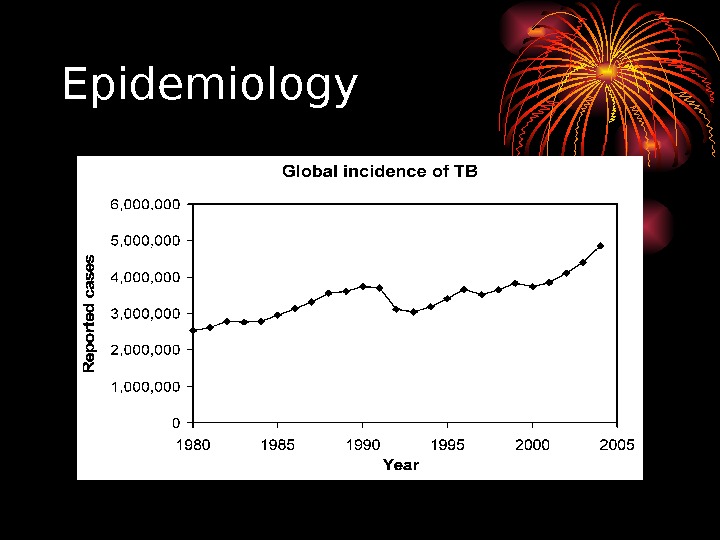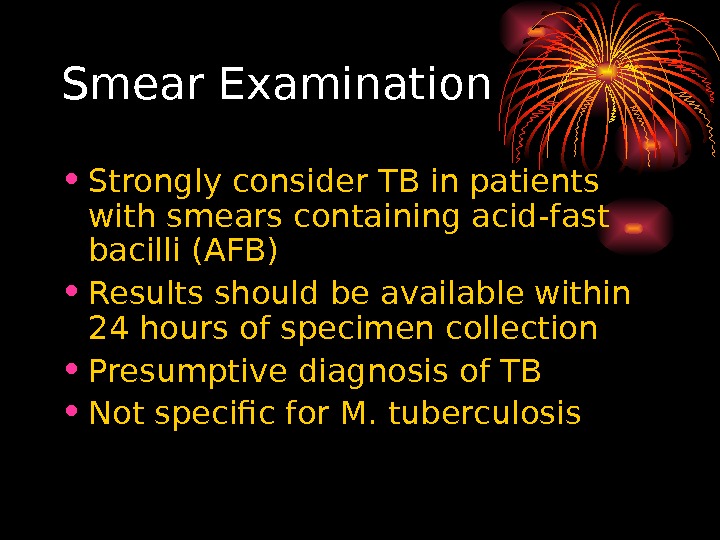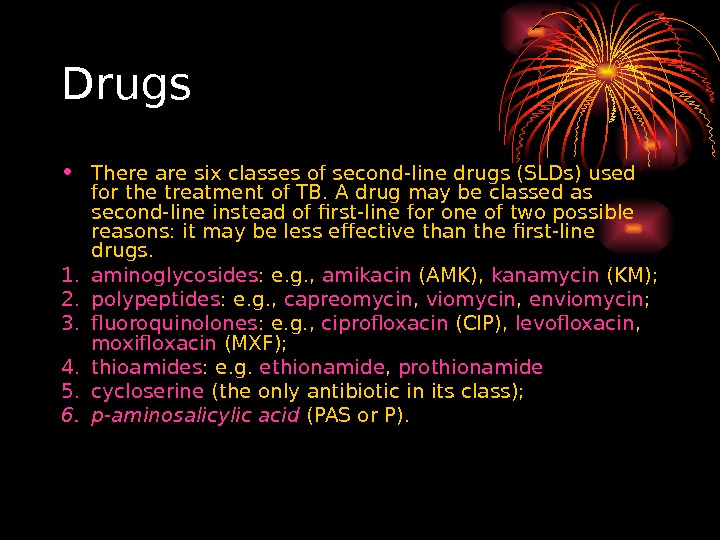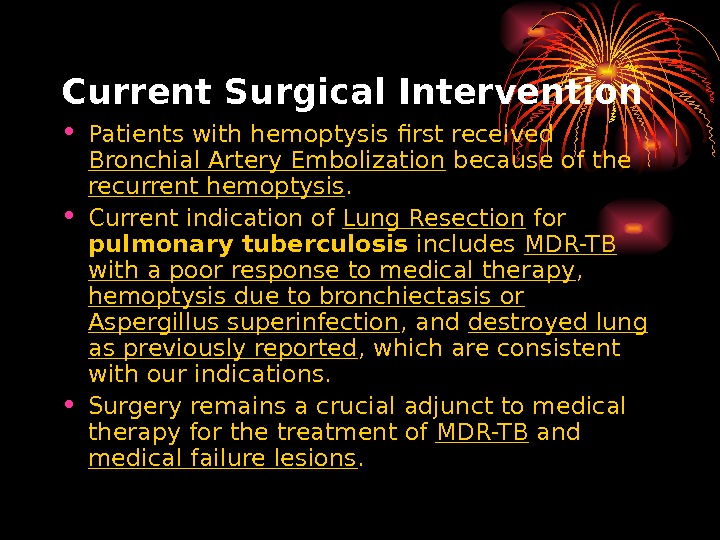Презентация pulmonary-tuberculosis-presentation-1233558968086589-2











































pulmonary-tuberculosis-presentation-1233558968086589-2.ppt
- Размер: 1.7 Mегабайта
- Количество слайдов: 42
Описание презентации Презентация pulmonary-tuberculosis-presentation-1233558968086589-2 по слайдам
 Pulmonary Tuberculosis By: Dave Jay S. Manriquez RN. February 1,
Pulmonary Tuberculosis By: Dave Jay S. Manriquez RN. February 1,
 Pulmonary Tuberculosis • Tuberculosis (abbreviated as TB for tubercle bacillus or T u b erculosis) is a common and often deadly infectious disease caused by mycobacteria , mainly Mycobacterium tuberculo sis. Tuberculosis usually attacks the lungs (as pulmonary TB).
Pulmonary Tuberculosis • Tuberculosis (abbreviated as TB for tubercle bacillus or T u b erculosis) is a common and often deadly infectious disease caused by mycobacteria , mainly Mycobacterium tuberculo sis. Tuberculosis usually attacks the lungs (as pulmonary TB).
 Pulmonary Tuberculosis • Scanning electron micrograph of Mycobacterium t uberculosis
Pulmonary Tuberculosis • Scanning electron micrograph of Mycobacterium t uberculosis
 Epidemiology • According to the World Health Organization (WHO), nearly 2 billion people—one third of the world’s population—have been exposed to the tuberculosis pathogen. • Annually, 8 million people become ill with tuberculosis, and 2 million people die from the disease worldwide. • In 2004, around 14. 6 million people had active TB disease with 9 million new cases. • The annual incidence rate varies from 356 per 100, 000 in Africa to 41 per 100, 000 in the Americas. • Tuberculosis is the world’s greatest infectious killer of women of reproductive age and the leading cause of death among people with HIV / AIDS.
Epidemiology • According to the World Health Organization (WHO), nearly 2 billion people—one third of the world’s population—have been exposed to the tuberculosis pathogen. • Annually, 8 million people become ill with tuberculosis, and 2 million people die from the disease worldwide. • In 2004, around 14. 6 million people had active TB disease with 9 million new cases. • The annual incidence rate varies from 356 per 100, 000 in Africa to 41 per 100, 000 in the Americas. • Tuberculosis is the world’s greatest infectious killer of women of reproductive age and the leading cause of death among people with HIV / AIDS.
 Epidemiology • Most common infectious cause of death worldwide • Latent phase of TB enabled it to spread to one third of the world population • 8, 000 new cases each year • 3, 000 infected patients die
Epidemiology • Most common infectious cause of death worldwide • Latent phase of TB enabled it to spread to one third of the world population • 8, 000 new cases each year • 3, 000 infected patients die
 Epidemiology
Epidemiology
 Epidemiology • Major changes in trends secondary to HIV — 1953 -1985 cases decreased from 84, 304 to 22, 201 — during this period cases were reactivation of old infection and elderly — TB and AIDS registries suggests that HIV-infected pts account for 30 -50% increase in cases of T
Epidemiology • Major changes in trends secondary to HIV — 1953 -1985 cases decreased from 84, 304 to 22, 201 — during this period cases were reactivation of old infection and elderly — TB and AIDS registries suggests that HIV-infected pts account for 30 -50% increase in cases of T
 Epidemiology • World TB incidence. Cases per 100, 000; Red => 300, orange = 200– 300, yellow = 100– 200, green = 50– 100, blue =< 50 and grey = n/a. Data from WHO ,
Epidemiology • World TB incidence. Cases per 100, 000; Red => 300, orange = 200– 300, yellow = 100– 200, green = 50– 100, blue =< 50 and grey = n/a. Data from WHO ,
 Incidence • 1985 -1990 TB cases increased 55% in Hispanics and 27% in African Americans • Populations at risk — Foreign-born individuals — Low socioeconomic status — Cancer pts — Celiac disease — Cigarette smokers — TNF-a antagonists — Corticosteroids • — HIV
Incidence • 1985 -1990 TB cases increased 55% in Hispanics and 27% in African Americans • Populations at risk — Foreign-born individuals — Low socioeconomic status — Cancer pts — Celiac disease — Cigarette smokers — TNF-a antagonists — Corticosteroids • — HIV
 Transmission • When people suffering from active pulmonary TB cough, sneeze, speak, or spit, they expel infectious aerosol droplets 0. 5 to 5 µm in diameter. • A single sneeze can release up to 40, 000 droplets. • People with prolonged, frequent, or intense contact are at particularly high risk of becoming infected, with an estimated 22% infection rate. • A person with active but untreated tuberculosis can infect 10– 15 other people per year. • Others at risk include people in areas where TB is common,
Transmission • When people suffering from active pulmonary TB cough, sneeze, speak, or spit, they expel infectious aerosol droplets 0. 5 to 5 µm in diameter. • A single sneeze can release up to 40, 000 droplets. • People with prolonged, frequent, or intense contact are at particularly high risk of becoming infected, with an estimated 22% infection rate. • A person with active but untreated tuberculosis can infect 10– 15 other people per year. • Others at risk include people in areas where TB is common,
 Transmission
Transmission
 Transmission • people who inject drugs using unsanitary needles, • residents and employees of high-risk congregate settings, • medically under-served and low-income populations, • high-risk racial or ethnic minority populations, • children exposed to adults in high-risk categories, • patients immunocompromised by conditions such as HIV / AIDS , people who take immunosuppressant drugs, • and health care workers serving these high-risk clients.
Transmission • people who inject drugs using unsanitary needles, • residents and employees of high-risk congregate settings, • medically under-served and low-income populations, • high-risk racial or ethnic minority populations, • children exposed to adults in high-risk categories, • patients immunocompromised by conditions such as HIV / AIDS , people who take immunosuppressant drugs, • and health care workers serving these high-risk clients.
 Pathogenesis
Pathogenesis
 Pathogenesis Hyperlink to Microsoft Word • Pathophysiology of Pulmonary Tuberculosis. doc • Pathogenesis of TB infection and disease. doc
Pathogenesis Hyperlink to Microsoft Word • Pathophysiology of Pulmonary Tuberculosis. doc • Pathogenesis of TB infection and disease. doc
 Diagnostics • Inject intradermally 0. 1 ml of 5 TU PPD tuberculin • Produce wheal 6 mm to 10 mm in diameter • Represent DTH (delayed type hypersensitivity)
Diagnostics • Inject intradermally 0. 1 ml of 5 TU PPD tuberculin • Produce wheal 6 mm to 10 mm in diameter • Represent DTH (delayed type hypersensitivity)
 Reading of Mantoux test • Read reaction 48 -72 hours after injection • Measure only induration • Record reaction in mm
Reading of Mantoux test • Read reaction 48 -72 hours after injection • Measure only induration • Record reaction in mm
 Classifying the Tuberculin Reaction • > 5 mm is classified as positive in • HIV-positive persons • Recent contacts of TB case • Persons with fibrotic changes on CXR consistent with old healed TB • Patients with organ transplants and other immunosuppressed patients
Classifying the Tuberculin Reaction • > 5 mm is classified as positive in • HIV-positive persons • Recent contacts of TB case • Persons with fibrotic changes on CXR consistent with old healed TB • Patients with organ transplants and other immunosuppressed patients
 Classifying the tuberculin reaction • >10 mm is classified as positive in • Recent arrivals from high-prevalence countries • Injection drug users • Residents and employees of high-risk settings • Mycobacteriology laboratory personnel • Persons with clinical conditions that place them at high risk • Children <4 years, or children and adolescents exposed to adults in high-risk categories
Classifying the tuberculin reaction • >10 mm is classified as positive in • Recent arrivals from high-prevalence countries • Injection drug users • Residents and employees of high-risk settings • Mycobacteriology laboratory personnel • Persons with clinical conditions that place them at high risk • Children <4 years, or children and adolescents exposed to adults in high-risk categories
 Classifying the tuberculin reaction • > 15 mm is classified as positive in • Persons with no known risk factors for T
Classifying the tuberculin reaction • > 15 mm is classified as positive in • Persons with no known risk factors for T
 Factors may affect TST • False negative • Faulty application • Anergy • Acute TB (2 -10 wks to convert) • Very young age (< 6 months old) • Live-virus vaccination • Overwhelming TB disease • False positive • BCG vaccination (usually <10 mm by adulthood) • Nontuberculous mycobacteria infection
Factors may affect TST • False negative • Faulty application • Anergy • Acute TB (2 -10 wks to convert) • Very young age (< 6 months old) • Live-virus vaccination • Overwhelming TB disease • False positive • BCG vaccination (usually <10 mm by adulthood) • Nontuberculous mycobacteria infection
 Chest Radiography • Abnormalities often seen in apical or posterior segments of upper l obe or superior segments of lower lobe • May have unusual appearance in HIV-positive persons • Cannot confirm diagnosis of TB !!
Chest Radiography • Abnormalities often seen in apical or posterior segments of upper l obe or superior segments of lower lobe • May have unusual appearance in HIV-positive persons • Cannot confirm diagnosis of TB !!
 Chest radiography • No chest X-ray pattern is absolutely typical of TB • 10 -15% of culture-positive TB patients not diagnosed by X-ray • 40% of patients diagnosed as having TB on the basis of x-ray alone do not have active T
Chest radiography • No chest X-ray pattern is absolutely typical of TB • 10 -15% of culture-positive TB patients not diagnosed by X-ray • 40% of patients diagnosed as having TB on the basis of x-ray alone do not have active T
 Specimen Collection • Obtain 3 sputum specimens for smear examination and culture • Persons unable to cough up sputum • induce sputum • bronchoscopy • gastric aspiration • Follow infection control precautions during specimen collection
Specimen Collection • Obtain 3 sputum specimens for smear examination and culture • Persons unable to cough up sputum • induce sputum • bronchoscopy • gastric aspiration • Follow infection control precautions during specimen collection
 Number of sputum samples required • overall diagnostic yield for sputum examination related to • the quantity of sputum (at least 5 m. L) • the quality of sputum • multiple samples obtained at different times to the laboratory for processing • 3 samples obtained at least eight hours apart with at least one sample obtained in the early morning
Number of sputum samples required • overall diagnostic yield for sputum examination related to • the quantity of sputum (at least 5 m. L) • the quality of sputum • multiple samples obtained at different times to the laboratory for processing • 3 samples obtained at least eight hours apart with at least one sample obtained in the early morning
 Smear Examination • Strongly consider TB in patients with smears containing acid-fast bacilli (AFB) • Results should be available within 24 hours of specimen collection • Presumptive diagnosis of TB • Not specific for M. tuberculosis
Smear Examination • Strongly consider TB in patients with smears containing acid-fast bacilli (AFB) • Results should be available within 24 hours of specimen collection • Presumptive diagnosis of TB • Not specific for M. tuberculosis
 AFB smear Mycobacterium tuberculosis (stained red) in sputum
AFB smear Mycobacterium tuberculosis (stained red) in sputum
 Cultures
Cultures
 Signs and Symptoms
Signs and Symptoms
 Signs and Symptoms • Hemoptysis • Also known as coughing up blood, it is a symptom of bleeding somewhere in the respiratory tract. Frothy and bright red blood may come from the nose, mouth, or throat (upper respiratory tract), the lower respiratory tract, or the lungs. The seriousness of the disorder depends on the cause of the bleeding.
Signs and Symptoms • Hemoptysis • Also known as coughing up blood, it is a symptom of bleeding somewhere in the respiratory tract. Frothy and bright red blood may come from the nose, mouth, or throat (upper respiratory tract), the lower respiratory tract, or the lungs. The seriousness of the disorder depends on the cause of the bleeding.
 Signs and Symptoms • Anorexia • The sysmptom of poor appetite whatever the cause
Signs and Symptoms • Anorexia • The sysmptom of poor appetite whatever the cause
 Treatment
Treatment
 Tuberculosis treatment • The standard «short» course treatment for tuberculosis (TB), is isoniazid , rifampicin , pyrazinamide , and ethambutol for two months, then isoniazid and rifampicin alone for a further four months. The patient is considered cured at six months (although there is still a relapse rate of 2 to 3%). For latent tuberculosis , the standard treatment is six to nine months of isoniazid alone. • If the organism is known to be fully sensitive, then treatment is with isoniazid, rifampicin, and pyrazinamide for two months, followed by isoniazid and rifampicin for four months. Ethambutol need not be used.
Tuberculosis treatment • The standard «short» course treatment for tuberculosis (TB), is isoniazid , rifampicin , pyrazinamide , and ethambutol for two months, then isoniazid and rifampicin alone for a further four months. The patient is considered cured at six months (although there is still a relapse rate of 2 to 3%). For latent tuberculosis , the standard treatment is six to nine months of isoniazid alone. • If the organism is known to be fully sensitive, then treatment is with isoniazid, rifampicin, and pyrazinamide for two months, followed by isoniazid and rifampicin for four months. Ethambutol need not be used.
 Drugs • All first-line anti-tuberculous drug names have a standard three-letter and a single-letter abbreviation: 1. ethambutol is EMB or E, 2. isoniazid is INH or H, 3. pyrazinamide is PZA or Z, 4. rifampicin is RMP or R, 5. Streptomycin is STM or S.
Drugs • All first-line anti-tuberculous drug names have a standard three-letter and a single-letter abbreviation: 1. ethambutol is EMB or E, 2. isoniazid is INH or H, 3. pyrazinamide is PZA or Z, 4. rifampicin is RMP or R, 5. Streptomycin is STM or S.
 Drugs • There are six classes of second-line drugs (SLDs) used for the treatment of TB. A drug may be classed as second-line instead of first-line for one of two possible reasons: it may be less effective than the first-line drugs. 1. aminoglycosides : e. g. , amikacin (AMK), kanamycin (KM); 2. polypeptides : e. g. , capreomycin , viomycin , enviomycin ; 3. fluoroquinolones : e. g. , ciprofloxacin (CIP), levofloxacin , moxifloxacin (MXF); 4. thioamides : e. g. ethionamide , prothionamide 5. cycloserine (the only antibiotic in its class); 6. p -aminosalicylic acid (PAS or P).
Drugs • There are six classes of second-line drugs (SLDs) used for the treatment of TB. A drug may be classed as second-line instead of first-line for one of two possible reasons: it may be less effective than the first-line drugs. 1. aminoglycosides : e. g. , amikacin (AMK), kanamycin (KM); 2. polypeptides : e. g. , capreomycin , viomycin , enviomycin ; 3. fluoroquinolones : e. g. , ciprofloxacin (CIP), levofloxacin , moxifloxacin (MXF); 4. thioamides : e. g. ethionamide , prothionamide 5. cycloserine (the only antibiotic in its class); 6. p -aminosalicylic acid (PAS or P).
 Drugs • considered «third-line drugs» • not very effective or because their efficacy has not been proven. • Rifabutin is effective, but is not included on the WHO list because for most developing countries, it is impractically expensive. 1. rifabutin 2. macrolides : e. g. , clarithromycin (CLR); 3. linezolid (LZD); 4. thioacetazone (T); 5. thioridazinea ; 6. arginine ; 7. vitamin D ; 8. R 207910.
Drugs • considered «third-line drugs» • not very effective or because their efficacy has not been proven. • Rifabutin is effective, but is not included on the WHO list because for most developing countries, it is impractically expensive. 1. rifabutin 2. macrolides : e. g. , clarithromycin (CLR); 3. linezolid (LZD); 4. thioacetazone (T); 5. thioridazinea ; 6. arginine ; 7. vitamin D ; 8. R 207910.
 Drugs • Daily Dose of TB Drugs
Drugs • Daily Dose of TB Drugs
 Drugs • Multi-drug resistant TB ( MDR-TB ) is defined as resistance to the two most effective first-line TB drugs: rifampicin and isoniazid. • Extensively drug-resistant TB ( XDR-TB ) is also resistant to three or more of the six classes of second-line drugs.
Drugs • Multi-drug resistant TB ( MDR-TB ) is defined as resistance to the two most effective first-line TB drugs: rifampicin and isoniazid. • Extensively drug-resistant TB ( XDR-TB ) is also resistant to three or more of the six classes of second-line drugs.
 Monitoring and DOTS • DOTS stands for «Directly Observed Therapy, Short-course» and is a major plan in the WHO global TB eradication programme. • The DOTS strategy focuses on five main points of action. 1. These include government commitment to control TB, 2. diagnosis based on sputum-smear microscopy tests done on patients who actively report TB symptoms, 3. direct observation short-course chemotherapy treatments, 4. a definite supply of drugs, and 5. standardized reporting and recording of cases and treatment outcomes.
Monitoring and DOTS • DOTS stands for «Directly Observed Therapy, Short-course» and is a major plan in the WHO global TB eradication programme. • The DOTS strategy focuses on five main points of action. 1. These include government commitment to control TB, 2. diagnosis based on sputum-smear microscopy tests done on patients who actively report TB symptoms, 3. direct observation short-course chemotherapy treatments, 4. a definite supply of drugs, and 5. standardized reporting and recording of cases and treatment outcomes.
 Prevention • TB prevention and control takes two parallel approaches. • In the first, people with TB and their contacts are identified and then treated. • Identification of infections often involves testing high-risk groups for TB. • In the second approach, children are vaccinated to protect them from TB.
Prevention • TB prevention and control takes two parallel approaches. • In the first, people with TB and their contacts are identified and then treated. • Identification of infections often involves testing high-risk groups for TB. • In the second approach, children are vaccinated to protect them from TB.
 Vaccines • Many countries use Bacillus Calmette-Guérin (BCG) vaccine as part of their TB control programs, especially for infants. According to the W. H. O. , this is the most often used vaccine worldwide, with 85% of infants in 172 countries immunized in 1993. • BCG provides some protection against severe forms of pediatric TB • unreliable against adult pulmonary TB, • Currently, there are more cases of TB on the planet than at any other time in history • urgent need for a newer, more effective vaccine that would prevent all forms of TB—including drug resistant strains—in all age groups and among people with HIV.
Vaccines • Many countries use Bacillus Calmette-Guérin (BCG) vaccine as part of their TB control programs, especially for infants. According to the W. H. O. , this is the most often used vaccine worldwide, with 85% of infants in 172 countries immunized in 1993. • BCG provides some protection against severe forms of pediatric TB • unreliable against adult pulmonary TB, • Currently, there are more cases of TB on the planet than at any other time in history • urgent need for a newer, more effective vaccine that would prevent all forms of TB—including drug resistant strains—in all age groups and among people with HIV.
 Current Surgical Intervention • Patients with hemoptysis first received Bronchial Artery Embolization because of the recurrent hemoptysis. • Current indication of Lung Resection for pulmonary tuberculosis includes MDR-TB with a poor response to medical therapy , hemoptysis due to bronchiectasis or Aspergillus superinfection , and destroyed lung as previously reported , which are consistent with our indications. • Surgery remains a crucial adjunct to medical therapy for the treatment of MDR-TB and medical failure lesions.
Current Surgical Intervention • Patients with hemoptysis first received Bronchial Artery Embolization because of the recurrent hemoptysis. • Current indication of Lung Resection for pulmonary tuberculosis includes MDR-TB with a poor response to medical therapy , hemoptysis due to bronchiectasis or Aspergillus superinfection , and destroyed lung as previously reported , which are consistent with our indications. • Surgery remains a crucial adjunct to medical therapy for the treatment of MDR-TB and medical failure lesions.
 Thank You
Thank You

